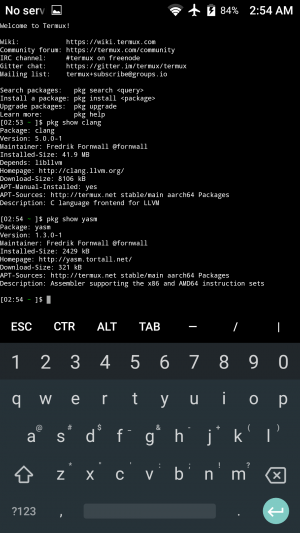ASM: Difference between revisions
mNo edit summary |
(Switch sources: use open-source code to avoid possible future copyright problems. Sorry, I am a paranoic) |
||
| Line 6: | Line 6: | ||
First <code>pkg install binutils</code>. Next, cut and paste the following into your Termux terminal: | First <code>pkg install binutils</code>. Next, cut and paste the following into your Termux terminal: | ||
cat >hello.s <<EOF | cat >hello.s <<EOF | ||
.data | |||
message: .asciz "Hello World" | |||
len = .-message | |||
.text | |||
.global main | |||
main: | |||
mov r0, #1 | |||
ldr r1, =message | |||
ldr r2, =len | |||
mov r7, #4 | |||
swi 0 | |||
mov r7, #1 | |||
swi 0 | |||
bx lr | |||
EOF | EOF | ||
| Line 61: | Line 63: | ||
= References = | = References = | ||
1) [ | 1) [https://github.com/leachim6/hello-world Hello World in every programming language] | ||
2) [https://www.npmjs.com/package/nectarjs Javascript's God Mode : one language to rule them all. Code everything, everywhere, for everything.] | 2) [https://www.npmjs.com/package/nectarjs Javascript's God Mode : one language to rule them all. Code everything, everywhere, for everything.] | ||
Revision as of 02:53, 15 September 2021
This section or list is incomplete. Please help to improve it.

First pkg install binutils. Next, cut and paste the following into your Termux terminal:
cat >hello.s <<EOF .data message: .asciz "Hello World" len = .-message
.text
.global main
main:
mov r0, #1
ldr r1, =message
ldr r2, =len
mov r7, #4
swi 0
mov r7, #1
swi 0
bx lr
EOF
as hello.s -o hello.o
ld hello.o -o hello
./hello
Your result: hello world
To see what you have made, use:
ls -al hello* cat hello.s
Note: code above is ARM Assembly, so it will only work on ARM 32-bit devices. For others architectures, you can find Hello World examples in Assembly for your architecture here
Packages
Use pkg show binutils to install binutils:
Package: binutils
Maintainer: @termux
Depends: libc++, zlib
Homepage: https://www.gnu.org/software/binutils/
Description: Collection of binary tools, the main ones being ld, the GNU linker, and as, the GNU assembler
Use pkg show yasm to install YASM:
Package: yasm
Maintainer: Fredrik Fornwall @fornwall
Homepage: http://yasm.tortall.net/
Description: Assembler supporting the x86 and AMD64 instruction sets
References
1) Hello World in every programming language
2) Javascript's God Mode : one language to rule them all. Code everything, everywhere, for everything.
3) More information about CLANG, ASM and Termux